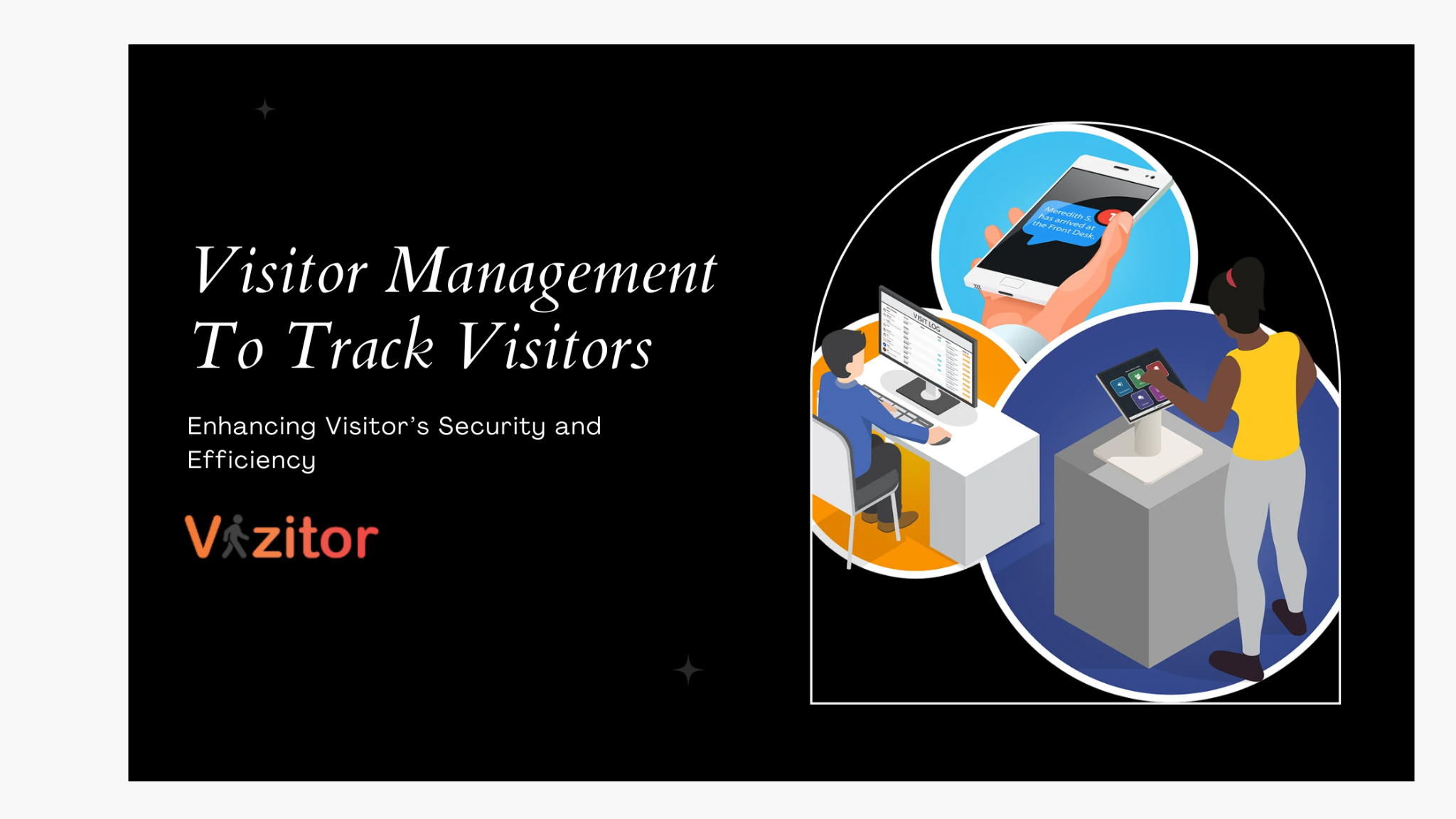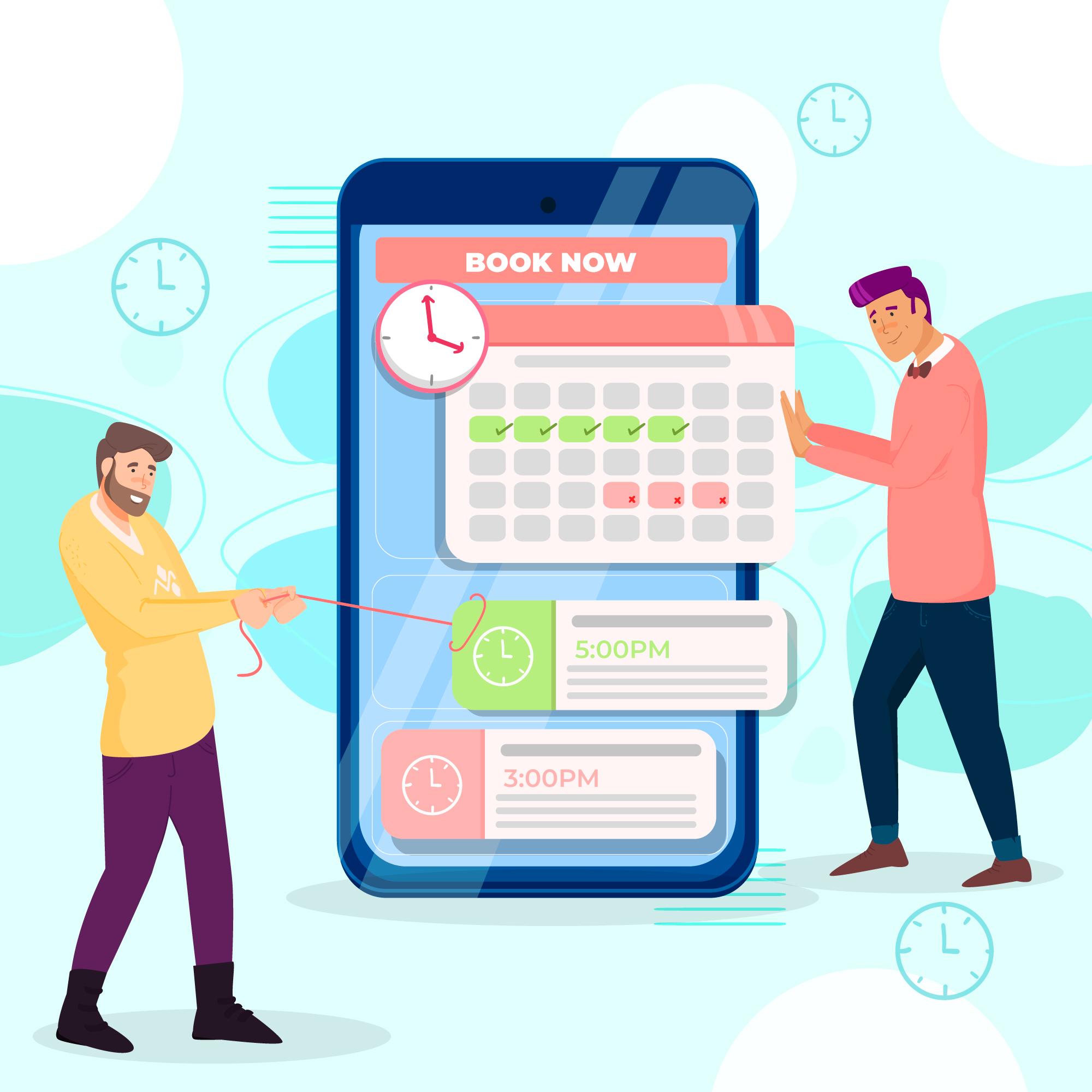Table of Content
Try Vizitor for Free!

Tue, Apr 1, 2025
Read in 19 minutes
Introduction
Do you keep track of who enters your premises? If you are running an enterprise, it must be your first and foremost priority to be aware of visitors and guests entering your building daily. Hence, organizations usually use visitor logs to keep track of visitors who come and go through your workplace.
But, Are these manual visitor logs safe and accurate? Obviously, A Big NO. Whether you are employing paper-based logs or others, it is upon you and your convenience. But still, understanding the need for an organization’s security and modernization, now companies are moving forward with digital solutions like Visitor Management Systems.
In this guide, we’ll explore:
- What visitor management really means
- Why it’s essential in 2025
- The benefits of digital solutions
- And how to choose the right system for your business
What is Visitor Management?
A visitor management system (VMS) is a digital tool that enables organizations to efficiently track, monitor, and manage visitors entering their facilities. It replaces outdated paper logbooks with a streamlined and automated process that enhances security, compliance, and visitor experience.
The visitor management system controls the entire visitor journey, from pre-registration to check-in, badge issuance, access control, and check-out. It helps ensure that every visitor is accounted for, their purpose of visit is recorded, and access is granted only where permitted.
Key features of a visitor management system include:
- Pre-registration forms
- Self-service check-in via kiosks or mobile apps
- Automatic badge printing
- Real-time visitor tracking
- Integration with access control and security systems
Implementing a visitor management system significantly improves organizational security and operational efficiency, while also offering visitors a professional first impression.
The need for visitor management stems from several key concerns. First and foremost, security is a primary driver. By implementing a structured visitor management system, organizations can mitigate the risk of unauthorized access to their premises. This process typically involves capturing visitor information, issuing identification badges, and tracking their movements within the building. This not only helps in preventing security breaches but also in identifying and responding to any suspicious behavior in real-time.
Visitor management is also crucial for operational efficiency. An effective system streamlines the check-in process, reducing wait times and improving the overall visitor experience. Pre-registration allows organizations to prepare for visitor arrivals, ensuring that they are greeted promptly and directed to the appropriate locations without unnecessary delays. Additionally, maintaining an accurate log of visitor activity can be
Here are key reasons why visitor management is needed:
- Enhanced Security: Visitor management helps prevent unauthorized access by ensuring that only vetted individuals can enter restricted areas. This is achieved through visitor registration, issuing access badges, and monitoring movements within the premises. In case of security incidents, having a detailed visitor log allows for quick identification and investigation of potential breaches.
- Improved Safety: During emergencies, knowing who is on-site and their whereabouts is crucial for effective evacuation and response. A robust visitor management system provides real-time information about all individuals present, which helps in ensuring that everyone, including visitors, is accounted for and safely evacuated if necessary.
- Operational Efficiency: Streamlining the visitor check-in process reduces wait times and improves the overall experience for guests. Pre-registration and automated check-in systems help to speed up the process and reduce administrative burdens on staff. This efficiency extends to managing visitor traffic and facility resources, contributing to smoother day-to-day operations.
- Regulatory Compliance: Many industries have specific regulations regarding visitor access and record-keeping. Implementing a comprehensive visitor management system helps organizations meet these requirements by maintaining accurate records of all visitor activity. This not only ensures compliance but also helps avoid potential legal and financial penalties.
- Data Collection and Insights: Visitor management systems often provide valuable data and insights about visitor patterns and behaviors. This information can be used to optimize security measures, improve facility operations, and enhance the overall visitor experience.
Why Visitor Management Is Important?
Visitor management and monitoring are crucial components of a comprehensive security strategy for any organization. Effective visitor management ensures that anyone entering the premises is properly logged, vetted, and accounted for. This process not only enhances security but also contributes to the smooth operation of the facility by controlling and managing visitor access efficiently.
Visitor management involves several key processes, including pre-registration, check-in, and badge issuance. By requiring visitors to pre-register, organizations can streamline the check-in process and ensure that only authorized individuals gain access to their premises. This advance notice allows security teams to perform background checks if necessary, ensuring that visitors are not a security risk. Upon arrival, visitors typically check in at a reception desk where they are issued badges that denote their authorization level and the areas they are permitted to access. This systematic approach reduces the risk of unauthorized entry and ensures that all visitors are accounted for.
Monitoring visitors in real-time adds another layer of security by providing continuous oversight of who is on the premises at any given time. Real-time monitoring allows security personnel to track visitor movement throughout the building, which can be crucial for identifying and addressing any suspicious behavior. It also helps in managing crowd control and ensuring that visitors adhere to facility rules. For organizations with high security requirements, such as financial institutions or healthcare facilities, this level of monitoring is essential for maintaining a secure environment and protecting sensitive information.
Here are key reasons why visitor management and monitoring are vital:
- Improved Security: By managing and monitoring visitors, organizations can significantly reduce the risk of unauthorized access and potential security breaches. Proper visitor management ensures that individuals entering the premises are known and vetted, while real-time monitoring allows for the immediate identification of any irregularities.
- Enhanced Safety: In the event of an emergency, having a clear record of who is on-site and their locations helps facilitate a quick and effective response. It ensures that all individuals, including visitors, are accounted for and can be safely evacuated if necessary.
- Regulatory Compliance: Many industries are subject to regulations requiring detailed records of visitor access and movement. Implementing robust visitor management and monitoring systems helps organizations comply with these regulations, avoiding potential legal and financial repercussions.
- Operational Efficiency: Efficient visitor management systems streamline the check-in process, reducing wait times and enhancing the overall visitor experience. Real-time monitoring also allows for better crowd management and resource allocation, contributing to smoother day-to-day operations.
Visitor Management Process Explained
The visitor management process is a structured series of steps that organizations follow to manage guests or external individuals on their premises. A well-defined process ensures security, compliance, and efficiency at every stage of the visitor’s journey.
Here is a breakdown of the typical visitor management process:
- Pre-Registration
Visitors provide their details, meeting purpose, and expected time of arrival via an online form or email invitation. This allows security teams to vet visitors in advance. - Arrival and Check-In
Upon arrival, visitors check in using a self-service kiosk, QR code, or with a receptionist. The system logs their arrival time and collects identity verification if needed. - Badge Issuance
The visitor is issued a printed or digital badge containing their name, photo, host details, and access permissions. - Access Control
Based on their role or purpose, visitors are granted or restricted access to certain areas within the facility. This is usually integrated with door access systems. - Real-Time Tracking
Security personnel can monitor visitor movements in real-time, ensuring that individuals are in authorized zones only. - Check-Out
Visitors check out at the end of their visit, and the system logs their departure time. This step ensures accurate records and supports emergency planning.
Having a defined visitor management process supports audit readiness, enhances workplace safety, and improves the overall guest experience.
Why Visitor Management Is Important for Every Workplace
Understanding why visitor management is important is essential for modern organizations concerned with safety, reputation, and compliance. Whether you operate a small office or a multi-location enterprise, having a visitor management strategy in place protects your people and property.
Here are key reasons visitor management is important:
- Security: Knowing who is in the building at any given time prevents unauthorized access and supports incident response.
- Compliance: Many industries are required to keep records of visitor activity to meet regulatory requirements, including HIPAA, GDPR, and ITAR.
- Emergency Response: During emergencies, having an accurate visitor log ensures that everyone can be accounted for.
- Brand Perception: A smooth, digital check-in process reflects professionalism and enhances visitor satisfaction.
- Data Accuracy: Manual logs can be illegible or incomplete. A visitor management system ensures reliable, time-stamped records.
For industries like healthcare, finance, and education, visitor tracking is not just a convenience—it’s a necessity.
Why Tracking Visitors is Important for Security-Minded Organizations
In today’s world, maintaining robust security protocols is essential for any organization, especially those handling sensitive information or operating in high-risk environments. One critical aspect of an effective security strategy is visitor tracking. By keeping a close watch on who enters and exits a facility, organizations can significantly bolster their security measures and safeguard their assets.
Visitor tracking provides a detailed record of who is in the building, which is invaluable in the event of a security breach or emergency. Knowing exactly who is present allows security personnel to quickly identify and address any unauthorized individuals. It also ensures that in case of an evacuation, all visitors can be accounted for, minimizing confusion and ensuring everyone’s safety. Additionally, maintaining a log of visitor entries and exits helps organizations to monitor patterns and detect any unusual behavior, which could indicate a security threat.
Here are key reasons why visitor tracking is crucial for security-minded organizations:
- Enhanced Security and Control: Tracking visitors helps prevent unauthorized access to restricted areas, ensuring that only those with proper credentials can enter sensitive zones. It provides an extra layer of security by documenting every person who comes into the facility, which can deter potential intruders.
- Emergency Response Efficiency: In emergencies such as fire alarms or medical incidents, having a detailed record of everyone in the building helps ensure that all individuals are accounted for and safely evacuated. This quick access to information can be critical in coordinating effective emergency responses.
- Compliance and Auditing: Many industries are subject to strict regulations regarding visitor access and security. Comprehensive visitor tracking systems help organizations comply with these regulations by maintaining accurate records, which can be crucial during audits or investigations.
Manual vs. Digital Visitor Management: A Comparison
As businesses evolve, many are choosing between manual visitor management and modern digital visitor management systems. The differences are clear in terms of security, scalability, and accuracy.
| Feature | Manual System | Digital Visitor Management System |
|---|---|---|
| Visitor Check-In | Paper logbook | Self-service kiosk, QR code, or mobile |
| Badge Issuance | Handwritten or none | Printed or digital with access levels |
| Data Storage | Physical records | Secure cloud-based storage |
| Real-Time Monitoring | Not available | Built-in visitor tracking |
| Emergency Response | Delayed manual checks | Instant access to real-time visitor logs |
| Integration with Security | Not possible | Fully integrable with access control |
| Reporting and Analytics | Manual, limited | Automated, detailed insights |
| Professional Appearance | Outdated and inconsistent | Modern and branded interface |
Using a digital visitor management system not only enhances security and compliance but also saves time and reduces human error.
What is an Electronic Visitor Management Solution?
An electronic visitor management solution is a digital system designed to streamline and enhance the process of monitoring and controlling visitors to an organization. Unlike traditional paper-based methods, which often involve manual logbooks and physical badges, electronic solutions leverage technology to automate, secure, and optimize visitor management tasks. This system integrates various functions to manage the complete lifecycle of a visitor’s interaction with the organization, from pre-registration to departure.
Core Features of Electronic Visitor Management Solutions
- Pre-Registration: Electronic visitor management systems often allow visitors to pre-register before their arrival. This feature enables organizations to collect essential information about the visitors, such as their names, contact details, purpose of the visit, and expected arrival time. Pre-registration helps streamline the check-in process and reduces wait times, as the system can prepare visitor details in advance, ensuring a smooth and efficient reception experience.
- Automated Check-In: Upon arrival, visitors can check in electronically using kiosks or mobile apps. These systems typically involve scanning a QR code or entering a pre-registered ID, which automatically retrieves their information from the database. This automation reduces the need for manual intervention, speeds up the check-in process, and minimizes errors associated with manual data entry.
- ID Badges and Access Control: After check-in, visitors are often issued digital ID badges or printed passes that include their name, photograph, and other relevant details. Some systems also integrate with access control systems to grant visitors access to specific areas based on their credentials. This helps in managing and restricting access to sensitive or high-security zones within the facility.
- Real-Time Monitoring: Electronic visitor management solutions provide real-time tracking of visitors’ movements within the premises. This feature allows security personnel to monitor who is on-site, where they are located, and how long they have been there. In case of an emergency or security incident, this real-time data is invaluable for ensuring that all individuals, including visitors, are accounted for and safely evacuated if necessary.
- Audit Trails and Reporting: These systems maintain detailed logs of visitor activity, including check-in and check-out times, visit durations and access history. This data can be used for auditing purposes, compliance with regulations, and analyzing visitor patterns. Comprehensive reporting capabilities also enable organizations to generate insights and improve their visitor management processes.
- Integration Capabilities: Many electronic visitor management solutions integrate with other organizational systems, such as security cameras, access control systems, and calendar applications. This integration helps to create a cohesive security environment and ensures that visitor management processes are aligned with other operational functions.
Benefits of Electronic Visitor Management Solutions
Let’s look into the benefits of electronic visitor log
- Enhanced Security: By automating visitor check-ins and issuing digital ID badges, electronic systems reduce the risk of unauthorized access and ensure that only vetted individuals can enter the facility. Real-time monitoring and integration with access control systems further enhance security by tracking visitor movements and controlling access to sensitive areas.
- Improved Efficiency: Electronic solutions streamline the check-in process, reducing wait times and administrative burdens on staff. Pre-registration and automated check-ins speed up visitor processing and enhance the overall experience for guests.
- Better Compliance: Electronic visitor management systems help organizations meet regulatory requirements by maintaining accurate and easily accessible records of all visitor activity. This compliance is crucial for industries with strict security and privacy regulations.
- Data-Driven Insights: The data collected by electronic visitor management systems provides valuable insights into visitor patterns and behaviors. Organizations can use this information to optimize security measures, improve operational efficiency, and enhance the visitor experience.
Types of Visitor Management Solutions
Visitor management solutions have evolved significantly from traditional manual systems to sophisticated digital platforms. These solutions are designed to enhance security, streamline processes, and improve the visitor experience. Here are the main types of visitor management solutions:
1. Manual Visitor Management Systems
Description: Manual visitor management systems are the traditional approach to tracking visitors, often involving physical logbooks, paper forms, and manual badge issuance. Visitors sign in upon arrival, providing their name, contact information, and the purpose of their visit. Reception staff then issue paper badges or passes.
Pros:
. Simple and low-cost implementation.
. No need for advanced technology or software.
2. Electronic Check-In Kiosks
Description: Electronic check-in kiosks are self-service terminals placed at entry points where visitors can check in using touchscreens. These kiosks typically allow visitors to enter their information, print visitor badges, and sometimes even capture photographs.
Pros:
. Faster check-in process compared to manual systems.
. Reduced administrative workload for reception staff.
. Visitors can easily update their information and print badges on their own.
3. Mobile Visitor Management Solutions
Description: Mobile visitor management solutions utilize smartphone apps or web-based platforms for visitor check-in and management. Visitors can pre-register, check in upon arrival, and receive digital badges via their smartphones. Visitor Management Features often include QR code scanning and real-time notifications.
Pros:
. Convenient for visitors who can manage their check-in process from their own devices.
. Reduces the need for physical infrastructure like kiosks.
. Integration with other mobile apps for seamless visitor experience.
4. Cloud-Based Visitor Management Systems
Description: Cloud-based visitor management systems offer a comprehensive digital solution hosted on remote servers. These systems provide a centralized platform for managing visitor data, issuing digital badges, and tracking visitor activity. Features often include real-time monitoring, integration with access control systems, and detailed reporting.
Pros:
. Accessible from any location with internet connectivity.
. Scalable and can be easily updated with new features.
. Integration capabilities with other organizational systems, such as security and calendar applications.
5. Integrated Visitor Management Systems
Description: Integrated visitor management systems combine visitor management with other organizational systems, such as security cameras, access control, and facility management. These solutions provide a seamless experience by integrating visitor management with existing infrastructure.
Pros:
. Enhanced security through integration with access control and surveillance systems.
. Streamlined operations and better coordination between different systems.
. Centralized data management and reporting.
6. Hybrid Visitor Management Systems
Description: Hybrid systems combine elements of both electronic and manual visitor management. For example, a facility might use electronic check-in kiosks but still maintain a manual log for backup purposes. Hybrid systems offer flexibility by blending technology with traditional methods.
Pros:
. Flexibility to use both modern and traditional approaches.
. Provides backup options in case of technology failures.
. Can be customized to fit specific organizational needs.
Wrapping It Up
Last but not least, digital visitor management solutions are essential for ensuring the smooth and hassle-free functioning of facilities. These systems serve as crucial security tools, playing a pivotal role in maintaining safety within organizations. By automating the visitor management process, organizations can not only enhance security but also improve operational efficiency. Tracking visitors and guests becomes especially vital during emergencies, as it ensures that all individuals are accounted for and can be quickly located, facilitating a more organized and effective response.
Digital visitor management solutions provide numerous benefits across various sectors. They enable contact-free check-ins and check-outs, which is particularly important in today’s health-conscious environment. This feature not only enhances the visitor experience but also reduces physical contact, aligning with hygiene and safety protocols. Additionally, these systems offer centralized management, making it easier to oversee and control visitor access across multiple facilities from a single platform.
Among the many options available, Vizitor stands out as an exceptional choice for managing visitors effectively. Here’s why Vizitor is considered one of the best solutions:
- User-Friendly Interface: Vizitor’s intuitive and easy-to-navigate interface simplifies the visitor management process. Both visitors and staff find it easy to use, reducing the learning curve and ensuring a smooth experience for everyone involved.
- Comprehensive Features: Vizitor offers a range of features designed to cover every aspect of visitor management. From pre-registration and automated check-ins to real-time tracking and detailed reporting, Vizitor provides a complete solution that caters to various organizational needs.
- Enhanced Security: With Vizitor, security is a top priority. The system integrates with access control and surveillance systems, ensuring that only authorized individuals gain entry to sensitive areas. Real-time monitoring and detailed logs further enhance security by providing visibility into visitor movements and access.
- Customization and Flexibility: Vizitor allows organizations to tailor the system to their specific requirements. Whether it’s customizing visitor badges, setting up specific access permissions, or integrating with other organizational systems, Vizitor offers the flexibility needed to accommodate unique needs.
- Cost-Effective Solution: Despite its comprehensive features, Vizitor offers a cost-effective solution that delivers excellent value for money. It eliminates the need for costly manual processes and reduces administrative overhead, making it a smart investment for organizations of all sizes.
- Seamless Integration: Vizitor integrates smoothly with other systems, such as calendar applications, security cameras, and access control systems. This integration ensures that visitor management is synchronized with other operational functions, creating a cohesive and efficient environment.
Frequently Asked Questions
1. Why is visitor management important for an organization?
Visitor management is crucial because it helps ensure security, compliance, and operational efficiency. It allows organizations to monitor and control who enters their premises, track their movements, and manage access to sensitive areas, thereby reducing the risk of unauthorized access and enhancing overall safety.
2. How does visitor management enhance security?
Visitor management enhances security by providing a detailed record of all visitors, including their identity, arrival time, and destination within the facility. This information helps in monitoring for unauthorized access, quickly identifying and addressing security breaches, and managing emergencies effectively.
3. What are the key benefits of tracking visitors?
Tracking visitors provides several benefits, including improved security, efficient management of access to restricted areas, better emergency response through accurate visitor records, compliance with regulatory requirements, and enhanced operational efficiency by streamlining check-in and check-out processes.
4. How does visitor tracking aid in emergency situations?
In emergencies, having a real-time record of all individuals on-site helps ensure that everyone is accounted for and safely evacuated. Visitor tracking allows for quick identification of their locations and facilitates effective coordination with emergency services to manage the situation efficiently.
5. What types of visitor management systems are available?
Visitor management systems range from manual logbooks and paper-based methods to electronic check-in kiosks, mobile apps, cloud-based platforms, and integrated systems that combine visitor management with other organizational tools like access control and security cameras.
6. How do electronic visitor management solutions improve efficiency?
Electronic visitor management solutions improve efficiency by automating check-ins, reducing wait times, and minimizing manual data entry. They also streamline the process of issuing badges, managing visitor records, and generating reports, thereby reducing administrative workload and enhancing the visitor experience.
7. Can visitor management systems integrate with other security tools?
Yes, many visitor management systems can integrate with other security tools, such as access control systems, surveillance cameras, and alarm systems. This integration provides a comprehensive approach to security, allowing for better monitoring and control of visitor access.
8. What role does pre-registration play in visitor management?
Pre-registration allows visitors to provide their details and purpose of visit before arriving at the facility. This advance notice helps streamline the check-in process, improves security by allowing background checks if necessary, and reduces wait times upon arrival.
9. How does visitor management support regulatory compliance?
Visitor management systems help organizations comply with regulations by maintaining accurate records of visitor activity, which can be crucial for audits and investigations. They ensure that visitor data is securely stored and easily accessible, meeting industry-specific requirements for record-keeping and security.
10. What factors should organizations consider when choosing a visitor management solution?
When choosing a visitor management solution, organizations should consider factors such as the system’s ease of use, scalability, integration capabilities with existing tools, security features, customization options, and cost. It’s important to select a solution that aligns with the organization’s specific needs and enhances overall security and operational efficiency.
11. What do you understand by visitor management?
Visitor management refers to the process of monitoring, controlling, and recording the entry and exit of visitors in a workplace or facility. It involves verifying visitor identity, granting access, and keeping logs for security and compliance purposes.
12. Why is tracking visitors important?
Visitor tracking is crucial for maintaining a secure environment. It ensures unauthorized individuals do not access sensitive areas and that all visitors can be accounted for in emergencies.
13. Is a visitor management system better than manual logs?
Yes, a visitor management system is more secure, accurate, and scalable than traditional paper-based logs. It automates data collection, enhances access control, and offers better insights.










